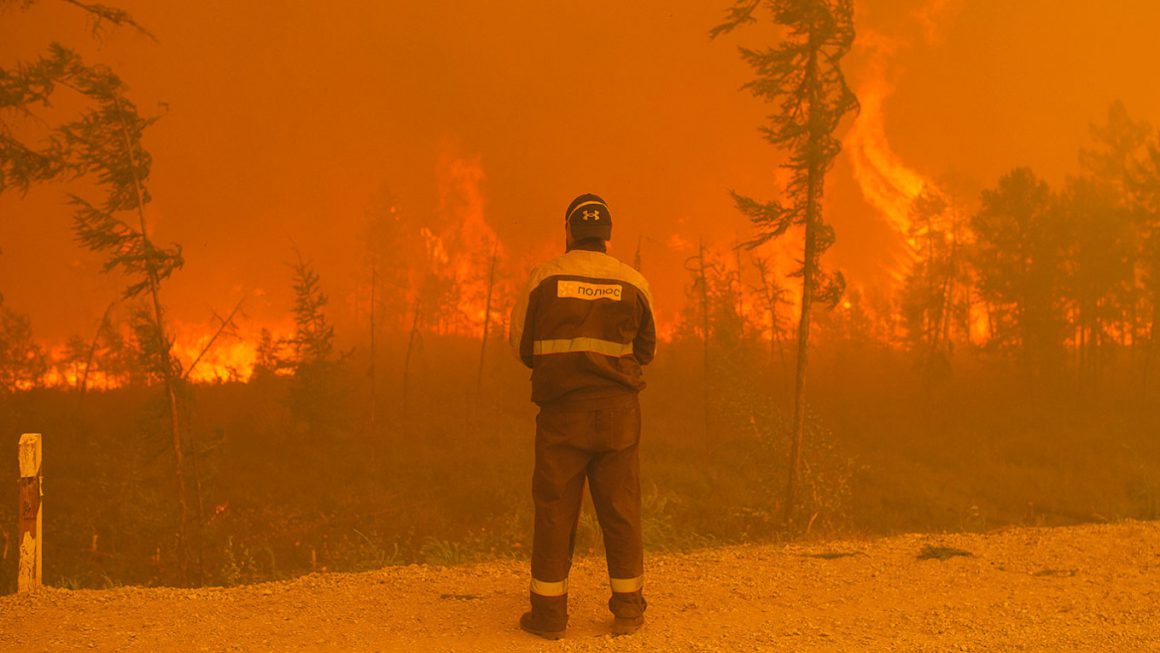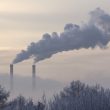By Dariya Kozhonova–Sotsialisticheskaya Alternativa — our sister organisation in Russia
Wildfires have raged on Earth as long as forests have existed. In some ecosystems, they are an integral part of reproduction cycles. This is true for the Siberian taiga. Due to the cold climate, low precipitation and the frozen ground, leaves and needles that fall to the ground do not decompose but lay on the ground for a long while. As a result, a large layer of flammable material accumulates and the soil itself is left poor. When a fire springs up, the needles burn fertilizing the soil with ash and destroying the old trees. New young trees replace them, and the forest is renewed. Normally, this cycle repeats every 70–300 years.
But human activity, or more accurately capitalist exploitation and climate change have led to fires unprecedented in area, speed of spread and destructive power. The world is ablaze — from the Siberian taiga to the Australian veldt and Amazon forests.
According to Greenpeace the area covered by fire in Russia since the beginning of 2021 has already reached 17 million hectares and with several weeks left of the fire season, this year will clearly see a record area destroyed. The Siberian fires alone are bigger than those currently burning in the rest of the world combined. The front that firefighters have to fight is over 2000 kilometers long.
Fires and climate change
The relationship between these catastrophic forest fires and climate change is two-way. On the one hand, changes in average annual temperature and precipitation patterns influence fire regimes; on the other hand, the wildfires themselves contribute to global climate shifts.
During the first decade of the 21st century, the average annual temperature in Siberia increased by 0.430C, and in the polar regions by 0.610C. The region is heating up twice as fast as other parts of the world, mainly due to a warming of the summer season and an increase in its duration. Average annual precipitation has also increased by 7.2 mm over the decade, but its distribution over the seasons is uneven. More snow in winter is compensated by summer droughts, which last for up to 110 days. This additional moisture increases the productivity of the forest ecosystem, and this leaves more flammable fuel to burn.
These climatic changes destabilize atmospheric circulation, and, as a consequence, cause strong gusty winds, which instantly inflate any fire that springs up so it reaches the treetops, and quickly spreads. In turn, an extensive fire creates its own weather regime. Rising currents of heated air reach the troposphere and block the passage of humid air masses from the Far East. Rains fall without reaching the focus of the fire.
Forest fires release soot into the atmosphere, which the wind blows towards the Arctic. If soot settles on the ice, the reflectivity of its surface is reduced, melting is accelerated, and freshwater flows into the ocean, which in turn affects surface currents. Soot and charcoal cover the ground, causing the melting of the permafrost, the degradation of which affects evaporation and moisture levels. In addition, there is an increase in the number of underground fires, which are difficult to extinguish and produce more toxic smoke than overhead or ground fires.
Plants are carbon stores. Through photosynthesis, they extract carbon from the atmosphere and recycle it as organic compounds that participate in various biological processes. But if a tree burns, much of the carbon it stores returns to the atmosphere as greenhouse gases. Carbon emissions from forest fires from 1998 to 2010 averaged 121+/-28 million tonnes per year, which is comparable to all the carbon emissions of, for example, the Czech Republic. This year has been worse. Since the beginning of June, as a result of fires in Siberia, 800 million tonnes of carbon dioxide have been released — more than the EU’s biggest polluter, Germany, emits in one year. Putin’s dictatorship, which has recently adopted its new environmental agenda has been gravely silent on this point.
Siberia’s forests are adapted to exist with a stable, cold climate. But now, excessively snowy winters with significant temperature variations and hot, dry summers can lead to water stress, vulnerability to pests, disease, and tree death. An abundance of deadwood creates a further fuel reservoir to encourage wildfires. The lack of systematic forest management and the use of forestry housekeeping caused by corrupt schemes exacerbate the problem. Currently, there are 250 full-time and 150 seasonal firefighters to cover an area 5 times that of France. This is a dramatic cut from the 1600 full-time staff employed in Soviet times.
Forest fires and human health
Forest fires negatively impact not only the environment but also human health. While only those people living in the disaster area are at risk of direct harm from the fire itself, the smoke and ash it generates are transported over hundreds and thousands of kilometers and contaminate the air and water over a wide area. The smoke contains polycyclic aromatic hydrocarbons, formaldehyde, phenol and other toxic and carcinogenic substances. In the short term, contact with these substances causes irritation of mucous membranes, eyes and the upper respiratory tract. Periodic prolonged exposure to smoke increases the risk of cancer and cardiovascular disease.
In addition to poisonous gases, smoke contains large amounts of particulate matter, consisting of carbon with minor mineral impurities. The usual criteria to measure air quality are defined as PM10 and PM2.5, indicating that suspended particles in the air are 10 microns and 2.5 microns in size respectively. PM10 is less volatile and the particles settle on the mucous membranes of the upper respiratory tract, irritating them. This poses a serious danger to people who suffer from asthma and cardiovascular disease. The smaller PM2.5 particles are more dangerous. They are more volatile, more able to penetrate into the lower respiratory tract and lungs. They accumulate in the alveoli and can cause chronic lung disease.
The chemicals that make up the ultra-dispersible particles are absorbed into the blood and have a toxic effect on the body. During forest and steppe fires the concentration of particles in the air exceeds normal levels by 10–14 times. Particle emission depends on the type of fuel and combustion mode. Slow smoldering wood is the most dangerous. Taiga and forest fires in temperate latitudes emit the most ultrafine material into the air, followed by tropical and steppe fires. In conditions of heavy smoke, it is extremely important to get reliable information about the state of the environment in a timely manner and to take appropriate measures to protect public health. Official data has long lacked credibility. Therefore, it is extremely important to develop civil air quality monitoring, horizontal warning systems and data exchange networks.
Ashes deposited after a forest fire are an important factor in ecosystem restoration, but they can also negatively affect the quality of water resources. Ashes contain large amounts of soluble nitrogen and phosphorus compounds and are carried by rainwater into rivers and lakes. Algae living there start to multiply rapidly due to the inflow of nutrients but soon die as they rapidly use up their supply. Oxidation (putrefaction) of the dead organic matter consumes any further dissolved oxygen in the water, increasing the number of stagnant waters. As well as this, the presence of large amounts of algae makes it difficult to purify and prepare drinking water. Ash, apart from nitrogen and phosphorus also contains mercury compounds that plants absorb from the soil during growth. This mercury then enters drinking water and accumulates in fish.
Another aspect that is rarely mentioned is that fires negatively affect not just the physical condition but also people’s mental state. In Australia, after the so-called Black Summer of 2019/20, 15% of firefighters and volunteers sought help for post-traumatic stress syndrome. How many more have not done so, one can only wonder. Communities that have faced the destructive power of fire for at least the next three years continue to have elevated rates of anxiety, alcoholism, suicide and domestic violence. In Russia, unfortunately, these problems are barely publicized, and victims often do not receive adequate psychological help.
Fires and the state. Bureaucracy and inefficiency.
The logging industry, along with the oil and gas industry, is a critically important source of income for the oligarchic elite. That is why for the past twenty years the federal centre, that is the Moscow-based bureaucracy, has been trying to concentrate control over it in its own hands. As a result of this “efficient management”, bureaucratic chaos, excessive regulation, confused authority, and, at the same time, a super-centralization of power and resources have been growing. Throughout the history of the Soviet Union, 774 documents regulating the use of forests were issued; over the last decades, 1,729. At the same time, many vital issues have remained unresolved. The huge number of confusing and contradictory laws and the endless reorganizations of the agencies responsible for forestry create fertile ground for corruption, red tape and irresponsibility.
The predatory nature of the federal government is most evident in financial matters. Before 2002, the fees for woodland rental and ‘stumpage fees’ went into regional budgets, the money used to protect and restore forest resources. Now, most of this money goes to the federal budget. As a result of this, the area of forest restored, which in the 1980s USSR was 1,800,000 hectares a year decreased to 950,000 hectares in 2000 and 800,000 hectares in 2004. Only in the past couple of years has the area restored approached a million hectares.
These are planned measures. When emergency situations arise, the regions have to wait for help from the centre. But for the Russian elite, extinguishing fires is “economically unprofitable”. Instead of ending their robbing and exploitation of the regions, the Moscow elite merges and enlarges the regions. By doing so they destroy local autonomy. Grassroots initiatives are also being suppressed. Any self-organization by workers frightens the authorities, and the volunteers fighting the fires in Siberia and Karelia are no exception. Instead of effectively involving activists in rescue work, they are bogged down by police checks and fraud cases.
The inefficiency of the state apparatus, corruption, and degradation of forest enterprises that are caused by these policies have led to a dramatic increase in illegal logging. According to various estimates, illegal logging accounts for 10–35% of timber harvested in Siberia and up to 60% in Russia’s the Far East. Clear-cutting, the shocking photos of which are published in the media, is a relatively rare phenomenon. It is much more common for trees to be felled selectively, under the pretext of housekeeping measures. It is difficult to assess such losses since a single tree on satellite images is smaller than a single pixel.
Forest fires play an important role in illegal logging. First, it is a way to conceal clear-cutting. Second, a rapidly spreading top fire destroys crowns and bark, but does not have time to damage the thick trunk itself. Burnt forests are written off, and the remaining trunks felled and documented as necessary “housekeeping.” Larch trees are cleared of small branches and needles by fire and sold. The situation is somewhat different in the Far East. While in Siberia mass illegal logging is used for construction timber, in the Primorye region, valuable species of wood are extracted under the guise of improving forest health.
For the ruling clique of oligarchs, extinguishing fires in Siberia is “economically unprofitable,” not because they are far away and hard to reach, but because without catastrophic fires it would be impossible to hide the scale of their corruption, incompetence, and predation. Without fires, they would not win their medals, earn money and gain more stars on their shoulders in recognition of their ‘emergency response’. As practice has shown, the Putin dictatorship does not care about climate change, or about forest preservation, or even the people whose homes are caught in the path of fires. Fires become not only a way for the Russian leadership to cover up their crimes but are also another chip to be played in their foreign policy games. Recently, instead of sending amphibian fire-fighting planes to Yakutia, they flew instead to Turkey.
A capitalist system geared toward making profit from man and nature is incapable of solving the problems it causes. The continued mindless exploitation and barbaric pillaging of forest resources is causing serious risks for human health, destroying unique ecosystems, and aggravating climate change. What can be done?
To keep fires under control we need to build a powerful mass movement uniting workers, firefighters, ecologists and local residents to fight:
- against the bureaucratic top-down structures that have been built to rob the regions and cover up illegal logging;
- for their replacement by a grassroots controlled and adequately funded forestry service to manage timely fire detection and the restoration of burned areas;
- for the restoration of the social sphere, which has been shattered by years of neo-liberal “optimization”, so that residents of fire-prone areas get access to free and locally appropriate medical care;
- for the establishment of workers’ control involving fire-fighters and residents with independent ecological monitoring to manage and oversee all aspects of forestry management, with all forestry land and resources taken back into public ownership;
- for a green, democratic, planned economy. Only in this way can we stop the barbaric exploitation of man and natural resources.
The forests of Siberia must once again become the lungs of the planet, not its exhaust pipe.












